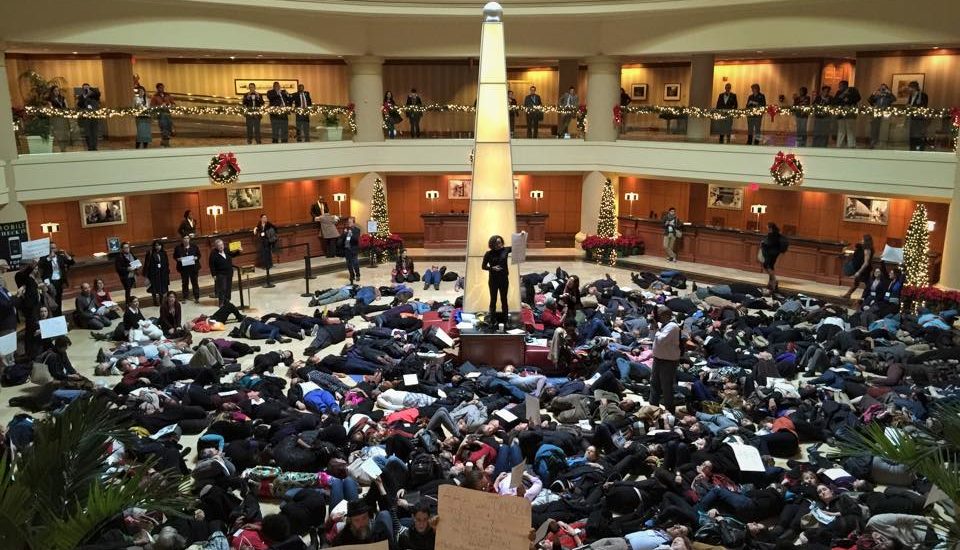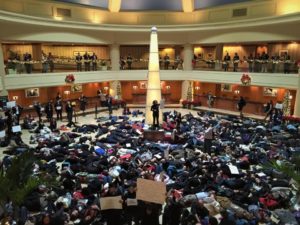- May 25, 2018
- Posted by: Irma McClaurin
- Categories: Black Lives Matter, Blog

These are trying times for Black activists, for feminists, for Black feminist activists–hell for anyone who has a modicum of awareness. In this era of Black Lives Matter (#BlackLivesMatter), what is needed are safe spaces to express authentic feelings without consequences, and mentoring as a form of shelter–where folk can retreat to for solstice and sanctuary.
This was brought home to a me a few years ago when I commented on a post in Anthropology Now. Written by a young black feminist activist, Donna Auston, who bravely had organized a “die-in” at the 2014 annual professional meeting of the American Anthropological Association. Her goal was to draw public attention to the Black Lives Matter movement, and the deaths of unarmed black men that seem to be increasing with a ferocity not seen since the Jim Crow era of lynching.
For a few minutes, she had created the most powerful example of what another Black feminist womanist activist taught me was “political theater.” instead of silence to protest the increased police violence against young black men, she orchestrated a “die in.”

What “drama” — in the best sense of that word.
And all of this took place at a professional academic conference attended by over 8,000 anthropologists of all ilks from around the world. And, it occurred in the main hotel lobby. After the event, Auston posted her thoughts in Anthropology Now about this public act of solidarity with the Black Lives Matter movement.
She began her post in the following way:
“I have never died before.
In the beginning of December, at the annual meeting of the American Anthropological Association in Washington, D.C., I made my way down to our hotel’s main lobby with a few of my friends, to join hundreds of my colleagues for a die-in, a powerful, symbolic protest against the continuing epidemic of extrajudicial killings of black citizens by police and vigilantes. We gathered a few minutes before the scheduled time, as instructions for how to begin arranging our standing bodies around the rotunda were whispered from ear to ear. “If you are planning to die, please make your way into the center of the circle, those who prefer to watch on the outside.” People began to hold up signs hastily scribbled on poster board and plain old blank office paper: “Black Lives Matter”, “Justice for All”—while one of the main organizers—a caramel-colored sister-scholar-organizer dressed in all black stood up on the pedestal that held up the tall, dangerously pointed objet d’art which marks the exact center of the lobby. Her muted signal came before I felt quite prepared. With a calm, direct, downward gesture of the hand we were informed that our time had come. Ready or not, it was time to die.
At exactly 12:28 P.M. we lay down on the immaculate marble floor in unison. Immediately, I felt my throat close and the rush of tears that I fought to hold back. “Dead women don’t cry,” I thought to myself, as I immediately became aware of my breath. Almost against my will, it felt—for dead women don’t breathe either—my lungs insisted on continuing to fill with air. As my lungs expanded so forcefully, I shed more tears as I thought of the violence and brutality with which Daniel Pantaleo literally squeezed the life out of Eric Garner. Garner, an asthmatic, was placed in an illegal chokehold and gradually robbed of air while he screamed repeatedly—over and over and over again—“I can’t breathe.” Read Full Article
On the post, I left a brief comment; but it was the email I received from Donna that broke my heart, but also reinforced why taking a few minutes to comment can have impact. She sent me this message:

Well said Sister anthropologist Auston. Praise be to those who mentored you and taught you to be bold. Many of us are aging, and we need to know there are still academics with fire in dem belly to carry on. We need to know that anthropologists (and especially Black Anthropologists) are connected to the everyday lives and events of social world where injustice reigns large. We need to know that you will continue to fight the good fight within the academic corridors and departments of anthropology and other disciplines where our white colleagues conduct research on social injustices around the world and practice intellectual racial brutality in their own departments, and never once stop to recognize the contradictions. I left UFlorida and renounced tenure because I had colleagues who told me in advance that they would never promote me to full professor years before I even considered applying for that status. How can you know in advance unless it is racism and sexism, and you have predetermined that this Black woman, in your white eyes, doesn’t deserve to be your full equal. But rather than dispair, I moved on to other spaces/places where I could do institutional change and make a difference in the struggle for authentic diversity, equity and inclusion. Black lives matter in the streets and they should matter in the academy. Perhaps we should consider a symbolic “die in” at every annual meeting of the AAA to remind our colleagues that they are responsible for taking the light out of the eyes of the Black and other non-white studens who take their classes as undergraduates or grads and seek affirmation that studying your own as a “native anthropologist” is a worthy intellectual pursuit of happiness and intellectual energy. Perhaps such an action would remind those who have brutalized my Black colleagues in the tenure process by making them jump through hoops that no one else has to that it is their own racist and white suprejmacist views that drives them to practice microaggressions and institutional intellectual brutality. And for those (white) colleagues who are allies, such an action would remind them to be stronger and speak out louder, and given even more support when they see us embattled. And for the people of color who have become the new gatekeepers and symbolic overseers, shame on you–time to find yourself. When I entered anthropology almost 19 years ago as a late PhD and a born-again anthropologist, I had such high hopes for the discipline. It had the potential for internal change through cultural critique. Today, as someone who works outside the academy by choice, but still stays in touch, I can truthfully say there is still much work to be done. The potential remains still remains. This die in and the reflections about its meaning are just the beginning, not the end. This is not only Behar’s “anthropology that makes you want to cry,” it is also the anthropoogy of the future–that makes you want to take action.
The moral of writing this post is to show that mentoring can take many forms; it can be something as simple as taking the time to leave a comment, placing your hand on the shoulder of an activist colleague who seems to be constantly under siege, and knowing when its time to step outside of the difficult situations, and take a breather.
White allies or those whites who seem concerned, what you can do is speak up–“if you see something, say something!” Stop rationalizing racist behavior. Start believing your colleagues and friends(?) when they tell you how they feel. Stop making it all about you, and taking their moment and turning it into your concern that people might confuse you for a racist. If you are silent on acts of psychological, emotional and intellectual violence against Black people and other persons of color, then you are complicit. No getting around it, the shoe fits, and you have to wear it. At least until you get right, and start taking the risks that Black activists have been taking most of their lives. Start your own protest. What would it look like if a bunch of white people organized an event stating “Black Lives Matter because we White People Say So!” Just a thought from that part of my mind that says “if this were a good and perfect world, more white people would protest the violence that is occurring against Black people.
Political activism is hard work for anyone. But Black political activism, Black feminist political activism, Black Lives Matter political activism is not only difficult, but dangerous.
Each time we stand our ground and protest, we are at risk of bumping into a history of orchestrated individual and state violence perpetrated against Black people for over three centuries, and that the legacy of that violence continues today, and is reflected in the deaths of Black men that gave rise to the BlackLivesMatter Movement.
What they don’t realize is that we are stronger than that. Exhausted, yes. Frustrated, hell yes. But give in to injustice–to the hell No! Black activism seems to be hardwired into some of our DNA. Of course, like all genes, it can skip some folk, so don’t be surprised if some “skinfolk” failed to get involved. But also, don’t be deterred, because as Donna Auston demonstrated, there is an entire generation of Black activists scholars who have been waiting in the wings, and have now taken center stage.
Make sure you show them some love every chance you get because of the history of abuse and brutality perpetrated against Black people in the Americas. We live with the legacy in our skin, in our memories, and in our ongoing daily interactions as we watch individuals and structures go out of their way to deny our humanity.
But we are stronger than they; we are more resilient than they. We are a people, a Black people who have survived the inhumane conditions since slavery and up to the present movement. And, we will NOT be moved.
(updated 8/12/2020)